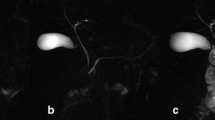Abstract
Background
Secretin administration during MRCP improves depiction of pancreatic ducts and allows assessment of pancreatic exocrine secretions. However, secretin increases the cost of secretin-enhanced MRCP (S-MRCP). The aim of this study was to quantify using MRCP the stimulating effect of 0.3 CU/kg of secretin and to compare it to the standard dose (1 CU/kg).
Methods
Ten healthy volunteers underwent four S-MRCP (two for each dose). Pancreatic exocrine secretions were quantified by pancreatic flow output (PFO) and total excreted volume (TEV), derived from a linear regression between MR calculated pancreatic exocrine volumes and time. Two readers analysed individually all sets of images.
Results
A linear increase of pancreatic exocrine volumes was observed after administration of both doses of secretin. Intra-individual and inter-observer differences were not statistically significant (P > 0.05). The mean PFO and TEV, given for reader 1 only, were, respectively, 6.9 ± 1.5 mL/min and 103 ± 26 mL for the standard dose and 6.1 ± 1.2 mL/min and 84 ± 19 mL for the dose of 0.3 CU/kg. Differences between PFO and TEV obtained with the two doses of secretin were statistically significant for both readers (P < 0.05).
Conclusions
MRCP is a non-invasive, reproducible tool that allows quantification of pancreatic exocrine secretions during secretin stimulation. PFO and TEV calculated with the low dose were still in the range of previously reported reference values. The administration of 0.3 CU/kg of secretin can reduce significantly the cost of S-MRCP.

Similar content being viewed by others
References
Somogyi L, Ross SO, Cintron M, et al. (2003) Comparison of biologic porcine secretin, synthetic porcine secretin and synthetic human secretin in pancreatic function testing. Pancreas 27:230–234
Malfertheiner P, Büchler M, Stanescu A, et al. (1986) Exocrine pancreatic function in correlation to ductal and parenchymal morphology in chronic pancreatitis. Hepato-gastroenterol 33:110–114
Ochi K, Harada H, Mizushima T, et al. (1997) Intraductal secretin test is as useful as duodenal secretin test in assessing exocrine pancreatic function. Dig Dis Sci 42:492–496
Robbrecht P, Cremer M, Vandermeers A, et al. (1975) Pancreatic secretions of total protein and three hydrolases collected in healthy subjects via duodenoscopic cannulation. Gastroenterology 69:374–379
Wada K, Yamadera K, Yokoyama K, et al. (1998) Application of pure pancreatic juice collection to the pancreatic exocrine function test. Pancreas 16:124–128
Matos C, Metens T, Devière J, et al. (1997) Pancreatic duct: morphologic and functional evaluation with dynamic MR pancreatography after secretin stimulation. Radiology 203:435–441
Manfredi R, Costamagna G, Brizi MG, et al. (2000) Severe chronic pancreatitis versus suspected pancreatic disease: dynamic MR cholangiopancreatography after secretin stimulation. Radiology 214:849–855
Fukukura Y, Fujiyoshi F, Sasaki M, et al. (2002) Pancreatic duct: morphologic evaluation with MR cholangiopancreatography after secretin stimulation. Radiology 222:674–680
Hellerhoff KJ, Helmberger H III, RöschT, et al. (2002) Dynamic MR pancreatography after secretin administration: image quality and diagnostic accuracy. AJR 179:121–129
Cappeliez O, Delhaye M, Devière J, et al. (2000) Chronic pancreatitis: evaluation of pancreatic exocrine function with MR pancreatography after secretin stimulation Radiology 215:358–364
Heverhagen JT, Müller D, Battmann A, et al. (2001) MR hydrometry to assess exocrine function of the pancreas: initial results of noninvasive quantification of secretion. Radiology 218:61–67
Punwani S, Gillams AR, Lees WR (2003) Non-invasive quantification of pancreatic exocrine function using secretin-stimulated MRCP. Eur Radiol 13:273–276
Bali MA, Sztantics A, Metens T, et al. (2005) Quantification of pancreatic exocrine function with secretin-enhanced magnetic resonance cholangiopancreatography: normal values and short-term effects of pancreatic duct drainage procedures in chronic pancreatitis. Initial results. Eur Radiol 15:2110–2121
Dreiling DA, Messer J (1978) The secretin story. Am J Gastroenterol 70:455–479
Pruessmann KP, Weiger M, Scheidegger MB, et al. (1999) SENSE: sensitivity encoding for fast MRI. Magn Reson Med 42:952–962
Nicaise N, Pellet O, Metens T, et al. (1998) Magnetic resonance cholangiopancreatography: interest of IV secretin administration in the evaluation of pancreatic ducts. Eur Radiol 8:16–22
Domschke S, Domschke W, Rösch W, et al. (1976) Bicarbonate and cyclic AMP content of pure human pancreatic juice in response to graded doses of synthetic secretin. Gastroenterology 70:533–536
Heverhagen JT, Battmann A, Kirsch M, et al. (2002) Magnetic resonance hydrometry: non-invasive quantification of the exocrine pancreatic function. Fortschr Röntgenstr 174:291–296
Bozkurt T, Braun U, Leferink S, et al. (1994) Comparison of pancreatic morphology and exocrine functional impairment in patients with chronic pancreatitis. Gut 35:1132–1136
Devière J, Gulbis B, Delhaye M, et al. (1985) Relation entre la morphologie canalaire et la fonction exocrine du pancréas: une méthode originale d’estimation linéaire de la fonction pancréatique. Acta Endoscopica 15:403–414
Author information
Authors and Affiliations
Corresponding author
Rights and permissions
About this article
Cite this article
Bali, M.A., Sontou, R., Arvanitakis, M. et al. Evaluation of the stimulating effect of a low dose of secretin compared to the standard dose on the exocrine pancreas with MRCP: preliminary results in normal subjects (MRCP quantification of secretin stimulation). Abdom Imaging 32, 743–748 (2007). https://doi.org/10.1007/s00261-006-9164-2
Published:
Issue Date:
DOI: https://doi.org/10.1007/s00261-006-9164-2




